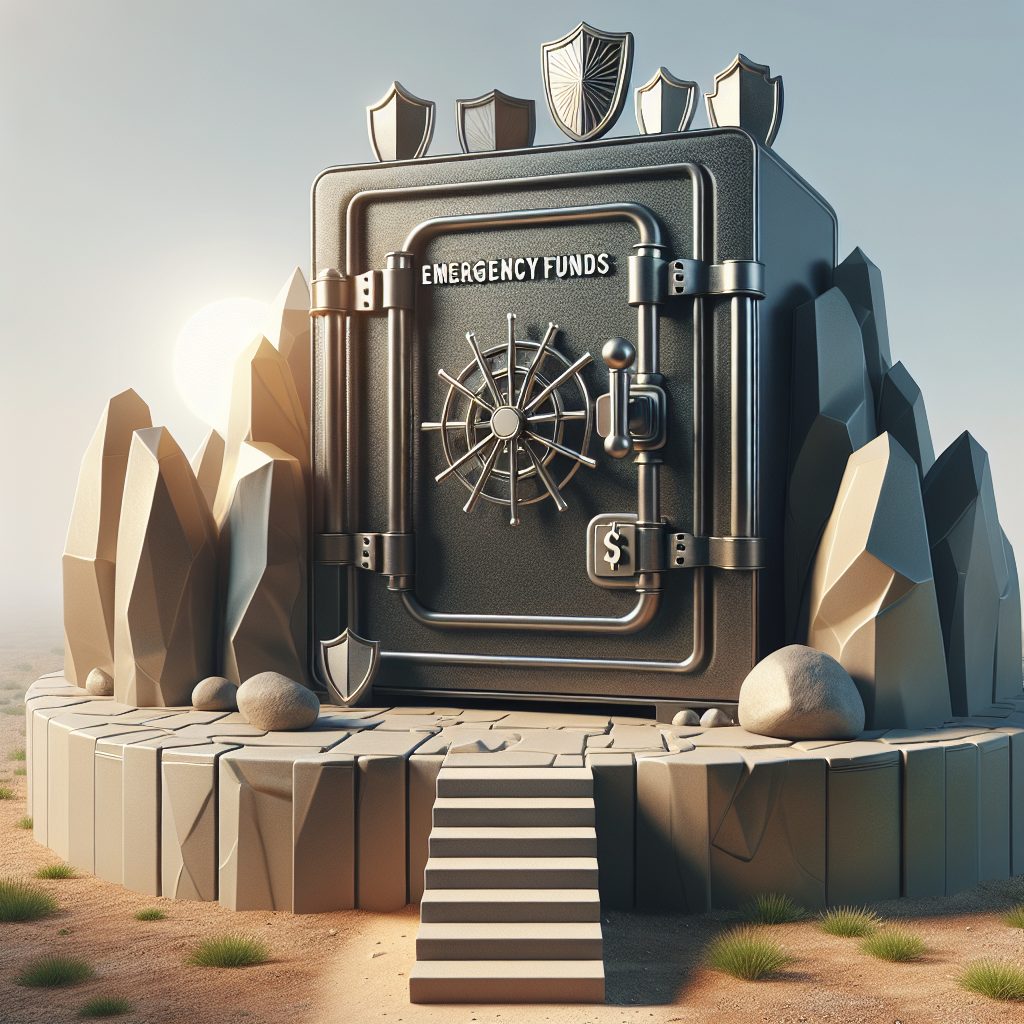Imagine landing on hard times with peace of mind, knowing you’ve got a financial cushion to soften the blow. That’s the power of an emergency fund—your financial security blanket. It’s the foundation upon which a stable financial future is built. In this article, we’ll dive into why stashing away funds for a rainy day isn’t just smart—it’s essential. You’ll learn how to start, where to keep your savings, and just how much you should aim to save.
We all face unexpected expenses now and then; car repairs that hit you out of the blue or medical bills that sneak up like uninvited guests. Without a safety net, these surprises can knock the wind out of your budget’s sails. But don’t fret; we’re here to guide you through setting up your first line of defense against life’s unforeseen costs. We’ll talk strategies for saving, tips for trimming expenses without feeling pinched, and how to keep your emergency fund growing. Get ready to take control of your finances and sail towards a more secure tomorrow.
Important Highlights
1. An emergency fund is a financial safety net designed to cover unexpected expenses or loss of income, without the need to incur debt or sacrifice other savings goals. Experts often recommend having at least three to six months’ worth of living expenses saved in an accessible account, such as a high-yield savings account, to ensure funds are readily available when needed.
2. Building an emergency fund should be a top priority; it’s the foundation for a solid financial plan. Start by setting small, achievable goals and gradually increase your savings over time. Even saving a small amount from each paycheck can accumulate significantly, providing peace of mind and reducing stress related to financial uncertainty.
3. The size of your emergency fund can vary based on personal circumstances, such as job stability, health considerations, and household income variability. Single-income households or individuals with fluctuating incomes, like freelancers, may require a larger buffer and should consider aiming for closer to six months’ worth of expenses.
4. Allocating money toward an emergency fund requires discipline and sometimes creative budgeting strategies. Cut non-essential spending where possible and consider utilizing windfalls, such as tax refunds or bonuses, to boost your reserves quickly. Automating transfers to your emergency fund can also help ensure consistent growth without requiring active management.
5. When tapping into your emergency fund, only use it for true emergencies—such as urgent car repairs, unexpected medical bills, or sudden job loss—and not for discretionary spending. After using any portion of these funds, prioritize replenishing the balance as soon as possible to maintain this crucial layer of financial protection.
Understanding Emergency Funds
An emergency fund serves as a financial safety net designed to cover unexpected expenses or financial downturns. Life can throw various unforeseen events our way, such as medical emergencies, sudden job loss, or urgent home repairs. Having an accessible cache of funds can be the difference between weathering a financial storm and being swept away by it.
The Ideal Size of Your Emergency Fund
Financial experts often recommend that your emergency fund should contain enough money to cover three to six months of living expenses. This size is a balance between being achievable for savers and providing enough cushion for most emergencies. However, the exact amount may vary based on individual circumstances such as job stability, health conditions, and lifestyle.
Starting Your Emergency Fund
Begins with setting a monthly savings goal. Even small contributions can build up over time. Open a separate savings account specifically for this purpose to avoid the temptation to spend these funds on non-emergencies. Online banks often offer higher interest rates, which can help your savings grow faster.
Strategies for Growing Your Emergency Fund
To effectively grow your emergency fund, consider automating transfers into your savings account. Additionally, funnel any windfalls such as tax refunds or bonuses directly into your emergency reserves. Cutting back on non-essential expenses can also accelerate your savings progress.
Where to Keep Your Emergency Fund
Your emergency fund should be easily accessible but not too easy to tap into for everyday spending. High-yield savings accounts, money market accounts, or short-term certificates of deposit (CDs) can be good options—each offering a balance of accessibility and return on investment.
Finding the Right Financial Institution
Select a reputable financial institution that provides the best combination of low fees and high-interest rates. Ensure that any account you choose is FDIC-insured or NCUA-insured to protect your funds.
Tapping Into Your Emergency Fund
Only use your emergency fund for true emergencies. This discipline will ensure that when dire situations arise, the resources will indeed be there. Be sure to replenish any amount withdrawn as soon as possible to maintain the fund’s intended level of security.
Maintaining Your Emergency Fund Over Time
Review your emergency fund periodically. As life changes—a new family member, a new job, or a pay raise—adjust your emergency fund accordingly. The goal should always be to have an adequate buffer in place to protect against life’s financial surprises.
Avoiding Common Pitfalls
Avoid treating your emergency fund like a revolving line of credit; doing so can lead to insufficient funds when an actual crisis occurs. Furthermore, resist the urge to invest these funds in volatile markets; the primary purpose is liquidity and stability rather than growth.
Risks of Not Having an Emergency Fund
Lacking an emergency fund exposes you to risk; it might force you into debt if an unexpected expense arises. High-interest debt from credit cards or loans can create long-term financial issues that are hard to recover from and undermine overall financial security.
Risk Mitigation Through Preparedness
Cultivating robust savings habits and maintaining vigilance over your emergency reserves helps mitigate risks associated with life’s uncertainties.
- Assess your monthly expenses and determine how much you need for three to six months’ worth of bills.
- Open a dedicated high-yield savings account exclusively for your emergency funds.
- Set up automatic transfers from checking to savings right after each payday.
- Prioritize replenishing any spent funds from the emergency account promptly.
- Regularly review and adjust the total amount in response to significant life changes or economic shifts.
- Maintain discipline by only using these funds for genuine emergencies—not wants or minor inconveniences.
Frequently Asked Questions
What is an emergency fund?
An emergency fund is a safety net of money set aside to cover unexpected expenses or financial downturns. It’s the cushion you can rely on when life throws a curveball, like medical bills or sudden job loss.
How much should I save in my emergency fund?
Ideally, aim to save three to six months’ worth of living expenses. That way, if you encounter any financial hiccups, you’ll have enough to keep you afloat without stress.
Where should I keep my emergency savings?
Your emergency savings should be easily accessible. A high-yield savings account or a money market account are good options that combine accessibility with some return on your investment.
Can I start an emergency fund while paying off debt?
Absolutely! Even if it’s just a small amount, gradually building your emergency fund while tackling debt can prevent you from falling deeper into debt when unexpected costs arise.
Is it necessary to have an emergency fund if I have a stable job?
Yes, emergencies don’t discriminate. Even with a stable job, unforeseen events can happen. An emergency fund acts as a buffer that protects your financial wellbeing.
How do I build an emergency fund on a tight budget?
Start small and stay consistent. Cut back on non-essentials and consider automating your savings. Over time, even small contributions will add up.
Should my emergency fund be separate from other savings?
Indeed, keeping your emergency fund separate helps avoid the temptation to dip into it for non-emergencies. It ensures the money is there when you really need it.
What counts as an emergency for using these funds?
An emergency is anything that’s unexpected and essential—think medical emergencies, urgent car repairs, or sudden unemployment. It’s not for planned expenses or wants.
How Can Having an Emergency Fund Support My Retirement Planning?
Having an emergency fund is crucial for retirement planning. It provides a financial safety net, allowing you to manage unexpected expenses without derailing your long-term goals. This stability supports effective strategies for starting retirement planning, ensuring that your investments remain intact and your future remains secure, even in times of crisis.
How quickly should I try to replenish my emergency fund after using it?
Prioritize replenishing your fund as soon as possible to restore your financial security net. Adjust your budget temporarily if needed to channel more money back into your savings.
Can investing be part of my emergency fund strategy?
It’s wise to keep the bulk of your emergency fund in liquid assets. However, once you’ve met your basic goal, some choose to invest additional savings for potential growth.
Closing Thoughts on Financial Preparedness
Anchoring your finances starts with establishing an adequate emergency reserve. This preventative step is not just about money; it’s about peace of mind and having the freedom to navigate life’s ups and downs without additional stress. By prioritizing the creation and maintenance of this financial buffer, you lay the groundwork for long-term stability and resilience against life’s surprises.
In conclusion, remember that consistency is key in building your rainy day reserve. No matter where you are on your financial journey, starting today sets the stage for a more secure tomorrow. Let this fundamental step empower you towards achieving greater financial security and independence.

